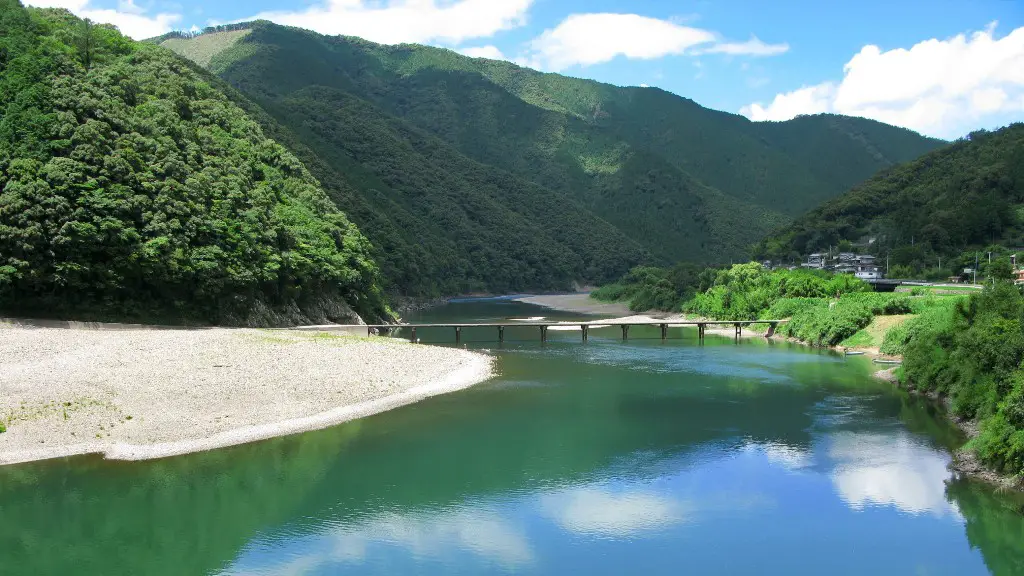The Yangtze River is the longest river in China and the third-longest in the world, stretching over 6,300 kilometers. Also known as Chang Jiang, it is the main waterway in the country and is the lifeblood of the Chinese economy. This mighty river has its source in the Geladandong Mountains in the Tibetan Plateau, then running in a southerly direction through the provinces of Sichuan and Yunnan before emptying into the East China Sea near Shanghai. While its exact course is shaped by its impressive geography, the Yangtze River passes through three of China’s most populous provinces: Sichuan, Hubei, and Jiangsu.
The provinces of Sichuan and Hubei are two of the most important provinces along the Yangtze River. Located in southwestern China, Sichuan is bordered by the Tibet Autonomous Region to the west and Hubei to the east. It has a population of over 81 million people, making it the fourth most populous province in the country. The province is also known for being the birthplace of the Three Kingdoms Period, one of the most important periods in Chinese history, and for being the home of the Giant Panda, one of the most beloved animals in the world. Hubei, on the other hand, is a major producer of the silk, cotton, and grain that is cultivated in its fertile valleys. With a population of over 60 million people, it is the eighth most populous province in China.
The Yangtze River ends in the province of Jiangsu, which is located in east-central China and is bordered by the Yellow Sea on its eastern coast. It has a population of over 79 million people and, like Sichuan and Hubei, is a major economic region, producing everything from steel, aluminum, and petrochemicals to garments, electronics, pharmaceuticals, and much more. Jiangsu is also home to the historic cities of Suzhou and Nanjing, both of which are major cities for business and tourism in China.
The Yangtze River provides essential resources to the people living in these provinces. In addition to providing fresh water for drinking, it also is used for a variety of industries, including hydroelectric power production and fishing. Hydroelectric power is generated at the massive Three Gorges Dam, located in Hubei, while fishing is an important source of food, income, and employment in the river’s provinces. The river is also a popular destination for tourists, with boat trips, cruises, and scenic views.
The Yangtze River has long been an integral part of many of China’s historical and cultural developments. It is said to be the birthplace of ancient Chinese civilization and was used for centuries for trade and transportation. It also served as an important barrier between the central and the coastal provinces of China, facilitating the development of different traditions and cultures in the region.
The Yangtze River is a critical element of Chinese culture and history and has played an important role in the economic and social progress of three provinces in particular. It is a source of life, of economic activity, and of a unique and beautiful landscape. Its significance is undeniable and, though its course may change, it will remain a source of pride and inspiration for the people of China for many years to come.
Environmental Impact
Despite the Yangtze’s importance to the people of the region, it has also had a significant environmental impact. From the displacement of communities living along the river to the destruction of wildlife habitats, the consequences of the Yangtze’s development have been far-reaching. In order to mitigate these impacts, the Chinese government has enacted a number of protective measures, such as zoning regulations, pollution control, and the preservation of wildlife habitats. However, much more needs to be done in order to fully understand the human and ecological impacts of the Yangtze’s development.
The Three Gorges Dam, for example, has been a source of great controversy due to its potential for devastating environmental impacts, including the potential for extreme flooding, landslides, and soil erosion. The dam has also been criticized for displacing more than 1.3 million people. Though the Chinese government has promised compensation to those affected, many of these families have still not been fully compensated.
Another issue of concern is the sharp decline in biodiversity in the region, owing to the fragmentation of the Yangtze’s habitats caused by human activities. Despite some areas being protected, the region is still affected by rapid deforestation, agricultural pollution, and pollution from sewage and industrial runoff. This has led to a significant decline in fish stocks, and many species are now facing extinction.
Given the importance of the Yangtze River to the region, it is essential that concerted efforts are taken to protect it from further damage. The Chinese Government has made some progress in this area, but more needs to be done in order to ensure the long-term health of the river and its ecosystems.
Economic Impact
The Yangtze River has been a major force in driving China’s economic growth over the past few decades. The development of the river’s trade and transport has enabled China to expand its exports globally, especially to markets such as the United States and Europe. It has also enabled China to become an important manufacturer of goods such as electronics, textiles, and machined parts.
The impact of the Yangtze has also been felt in the region’s local economies. Smaller towns and cities along the river have seen their economies grow as a result of the development of ports and the provision of rail and road transport links. The influx of people, goods, and capital has also seen an increase in job opportunities in the region. In addition, the development of tourism in the region has brought economic benefits to many local businesses.
The Yangtze River is also a major source of freshwater, providing drinking water to millions of people in the region. This is especially vital for cities, such as Chongqing, where two thirds of the area’s water originates from the river. It also supplies the Yangtze’s extensive network of canals and lakes, making it an important provider of irrigation, navigation, and power.
The Yangtze River has had a profound impact on the economy of the provinces through which it flows. It has increased the flow of goods and services in the region, while also providing invaluable sources of freshwater, energy, and employment. In this way, it has played a vital role in transforming three of China’s most populous provinces.
Cultural Significance
The Yangtze River is not only an important element in China’s economic and environmental landscape, but is also deeply rooted in the region’s cultural identity. Many of China’s iconic landmarks, such as The Great Wall of China and the spectacular Three Gorges of the Yangtze, are located along its banks.
The story of the region’s rich cultural heritage is deeply intertwined with the River. Numerous cultural symbols, such as the Yangtze’s giant pandas and the three-legged crow, have endured through the centuries and have become entrenched in the culture of the Yangtze’s provinces.
The Yangtze has also served as a source of inspiration for countless writers, poets, and artists. The region’s stunning landscapes have inspired a number of famous Chinese painters and writers, while the picturesque views of the River have been captured in numerous films, photographs, and paintings. The Yangtze is also deeply connected to traditional Chinese beliefs and philosophies, representing an important part of the country’s spiritual heritage.
The importance of the Yangtze River, both culturally and economically, is undeniable. By connecting China’s vast network of provinces and providing a source of life-sustaining resources, the River has become an essential element of China’s cultural and economic identity.
Conclusion
The Yangtze River has been an integral part of China for centuries, providing essential resources to the three provinces through which it flows – Sichuan, Hubei, and Jiangsu. It has enabled the economic and social progress of the region and is deeply rooted in the culture and identity of China. Despite the environmental and economic challenges posed by the River’s development, it still holds an immense amount of significance and importance to the people of the region.





